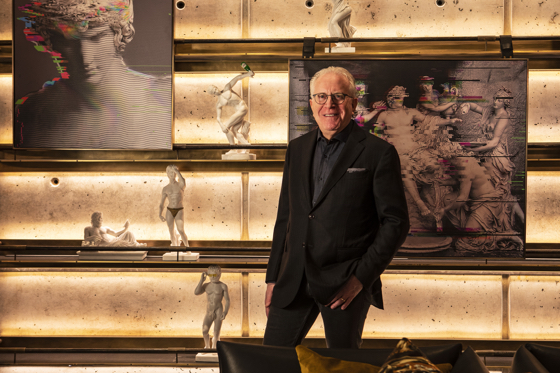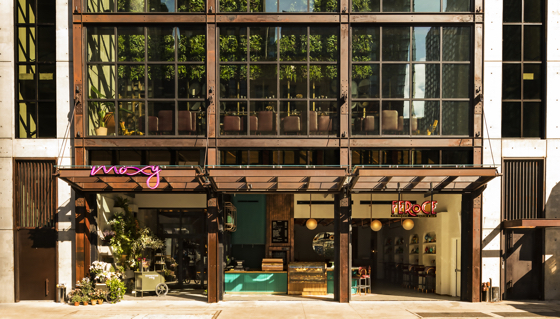About 10 years ago, New York-based real estate developer and investor Lightstone and its president, Mitchell Hochberg, started trying to figure out how, in their expensive-to-build city, they could create hotels at lower prices per key. They investigated different construction techniques, building prefabricated spaces, and other options.
During the course of their research they started thinking about how hotel rooms in Europe were much smaller and started working on their first micro rooms, eliminating inefficiencies of the prototypical large urban luxury hotel model with turn-down service. At the same time, they wanted large, all-day dining and drinking venues and engaging programs that aligned with the evolving consumer.
“Historically, hotels have been designed to make use of meeting rooms during the day, restaurants in the evening and nightclubs at night, with each venue sitting vacant the majority of the time,” Hochberg told HOTELS during a July interview. “Today, travelers and locals alike are using hotels as the new town square – a hotel lobby may double as a co-working space and a lunch spot during the day, while that same space may become a DJ-fueled lounge at night. I expect we’ll see more and more of this (in particular, on the co-working and flexible meeting space side) as owners focus on meeting the demands of their guests while finding additional revenue streams.”

Then came Marriott International’s launch of a micro-brand, Moxy – not surprisingly in Europe. Lightstone knew it needed a brand partner to make it work and approached Marriott to encourage leadership to expand into the United States a little bit sooner than it wanted. The two companies worked closely to articulate the American version of the brand and gave Lightstone more flexibility to develop a product that worked in New York City and made sense for it as an owner.
Today, Lightstone’s 100%-owned Moxy platform in New York City consists of the first hotel opened two years ago in Times Square; one in the Chelsea neighborhood that opened this year; one in the East Village scheduled to open this month; and one in the Bowery opening in two years.
There are also projects under development in South Miami Beach, downtown Los Angeles and another not yet announced, according to Hochberg. All the New York hotels are managed by close partner Magna Hospitality of Warwick, Rhode Island, but Lightstone control the marketing and works directly with food and beverage partners.
“One of the reasons we’ve gone so deep with Moxy is we think we really have a formula nailed and know how to execute it well,” said Hochberg, a 30-year developer and operator who, among other things, has served as COO of Ian Schrager Co. and sat on the board of luxury hotel company Belmond. “In New York, in particular, we have a development team that is very savvy on land acquisition and that has been instrumental in us being able to secure a very attractive basis for all the properties.”
With so many other micro-brands emerging from brands and smaller groups, the big question for Lightstone is: How is Moxy working out? Hochberg’s answer: “Very well, and it is actually exceeding our expectations.”
When Lightstone opened the first Moxy in Times Square, Hochberg said everybody was nervous, particularly lenders, at proof of concept. When it opened strongly, everybody relaxed.
“What we’re doing with Moxy is different than the others because we’ve decided to only focus on gateway cities and bigger hotels,” he said. “As a result, the hotels necessitate robust food and beverage, which is not part of the standard Moxy.” For example, the Chelsea hotel has a lobby lounge that unfolds as a succession of dining and hangout spaces designed to transform from live to work to play over the course of the day. It also has an all-season alfresco garden terrace serving comfort food, while a restaurant and separate café focus on Italian dining and baked goods. In addition, a rooftop lounge is busy day and night.

When asked what percentage of revenue F&B accounts for, Hochberg would only say that it is a “significant part of the revenue but not a significant part of the NOI (net operating income). And that’s what’s important, so the whole purpose of the food and beverage is to drive RevPAR. Now clearly we wouldn’t do it unless it was profitable, but one of the things we’re very cognizant of is we didn’t want to run a bunch of restaurants and bars with rooms on top. We’re in the hospitality business and we’re in the rooms business, and that by far is the most important thing. So it is not a significant part of the bottom line.”
Hochberg said Marriott’s distribution contribution is very high and customer satisfaction scores, in general, “are pretty good.” “We still get complaints about the size of the rooms, for instance, but that obviously is what the deal is we have with guests,” he added.
Lightstone does meeting space differently as well. “We tend not to have conventional meeting rooms. In Moxy Times Square, we built studios as part of the lobby that were glass-enclosed rooms that had conference tables that you could either rent for the day or you could just come in and squat in the rooms and use them for meetings,” Hochberg said. “We felt most of our guests were people that were in the creative world and didn’t need a conference room – they just needed a space and they loved the energy of being part of the lobby.”
He says those meeting spaces are almost booked 18 hours a day. At night when they weren’t being used, the conference tables become more a part of the lobby experience. But Hochberg said it didn’t feel quite right.
“So when we went to Chelsea, we went to [designer] David Rockwell and I said, ‘I want you to take the studios and design them so that they could deconstruct into a lounge area and be taken apart by a 110-pound woman in five minutes.” The studios’ glass doors slide and fold into the wall. The conference tables collapse into credenzas and the seats come together as sofas.
Overall, Hochberg said Lightstone is very happy about how both open Moxys are performing compared with their comp sets. Chelsea, in particular, which opened in February, is significantly over 100 RPI (RevPAR index), and Times Square is hovering around 100 and still ramping. “So even though the market is off a bit, we’re getting more than our fair share and we’re happy about it because both hotels have been well accepted.”
